Act now and Aotearoa could own Democracy Day 2021
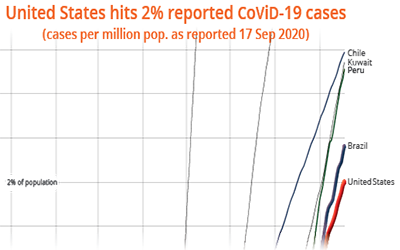
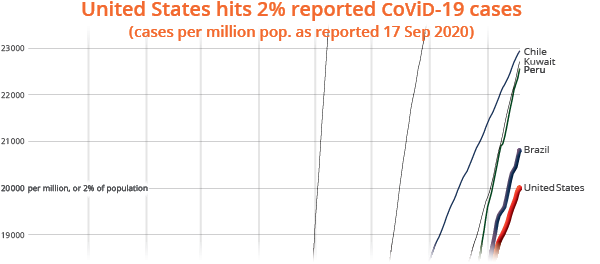
Mainstream Media Misses 2% Milestone: With the United States’ reported covid-19 infection rate hitting 2%, the mainstream media, indignant about its marginalisation by online news sources, only has itself to blame for not noticing the world’s most populous flawed democracy reaching a milestone underlining its woeful dysfunctionality, and two days after Democracy Day. graph Mahurangi Magazine | data Our World in Data 17 September 2020
With Donald Trump’s best prospects now being immediate resignation and a prompt Mike Pence pardon, the United States’ flawed democracy might now survive long enough to face redemption.
Shy seven weeks, it is 20 years from the United States election that, thanks to its patently flawed, undemocratic—and its perversion of the popular vote 61% unwanted—institution of the electoral college, handed the presidency to the loser of the popular vote—by 547 398 votes—George w Bush. But in addition to the pointing and laughing, which is about to repeat, the world’s first full democracy, Aotearoa, needs to be addressing the patently undemocratic flaws in its own democracy.
Just one of its flaws, the 5% threshold for a party to gain seats in the legislature, could well cost the seriously-in-the-shade-of-Labour, Green Party. Some, such as business commentator Rod Oram, are effectively pleading for the Green Party to be supported, alluding to the indisputable fact that as serious as the covid-19 pandemic is, global warming will be the far greater killer. Be that as is may, given how impatient the opposition is to put business before what could prove to be the most lethal pandemic in a century, many voters will be exercised by the need to ensure the Labour-led response is now not sacrificed on the altar of a false dichotomy. With Labour Party polling putting the Greens below 5%, and historically minor coalition partners failing clear that threshold, the probability of Green Party votes being wasted is extremely high.
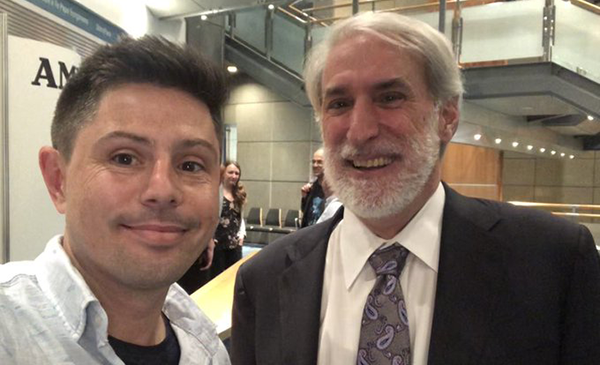
Losing Green Energy Spokesperson: When announcing his retirement, Gareth Hughes may have extolled his Green Party colleagues to think big, but not only does none seem to want to be associated with the one meaningful energy initiative to materialise in four decades—the Lake Onslow pumped hydro storage scheme—the party has no one seemingly wanting Hughes survivable-climate-pivotal energy portfolio. Hughes, who lost his bid to lead his party in 2015, pictured in 2019 with visiting artificial photosynthesis proponent Professor Daniel g Nocera. image Gareth Hughes
Then there is the small matter about how potent Green Party policy really is, on climate-action mobilisation. The Mahurangi Magazine contends that Lake Onslow pumped hydro storage now being explored by the Labour-led government is what climate-action mobilisation needs to look like. Pandering to electric cars—even short the blatantly populist National Party proposal to prioritise ev road space by permitting them in bus lanes, in part in the hope of precipitating a peak-bus backlash—is neither green nor climate leadership. Regardless of the party’s consistent failure to show meaningful climate action leadership, voting Green should still be an option for those wanting to push the two major parties in that direction, without the risk of wasting that vote on account of the beyond-crude 5% threshold.
Inspired by its 1986 redemocratisation, the Philippines did deserve to be the annual focus of Democracy Day. But since leading the 2016 descent into populism, in its most murderous manifestation, the world’s 13th-most populous country is also, predictably, a covid-19 basket case. In the toxic disinformation stakes, Duterte’s advice to wash facemasks in petrol rivals Trump’s encouragement to inject bleach. But whereas Trump dreamt of disguising the United States’ infection rate, Duterte succeeded, his corrupt health minister reporting, implausibly, a rate for the Philippines south of Norway’s. The country’s heath department, on 3 August, reported having 2000 test kits, for a population of nearly 110 million—slowing the spread of information, but not of covid-19.
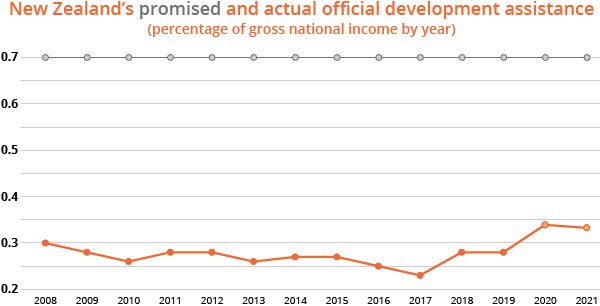
Promise Less Than Half Met: For a wealthy country, Aotearoa falls awfully short with its official development assistance rate. Luxembourg leads the leader board, at 1.05% of gross national income, followed by Norway, Sweden and Denmark as countries spending more than
New Zealand’s promise of 0.7%—less than half fulfilled, even if it hits the planned increase to 0.34% in 2020. Aotearoa could lead the world in the development of democratic systems that allow voters to directly pressure governments to keep specific promises. chart Mahurangi Magazine | data Stuff | Ministry of Foreign Affairs and Trade
As the world’s first full democracy, Aotearoa, with a bit of work, could consummately lead the global Democracy Day celebrations. The primary head-turner would be annual online elections, held on a Mondayised, holidayised Democracy Day. The reaction of most living in democracies with three-, four-, and five-year electoral cycles—and even Americans, with their two-year cycle of Congress—would be one of incredulity. But then it would dawn, that implemented as part of a thorough overhaul and updating of representative democracy, annual elections free of campaign years and billboard-lined streets, could be far more agreeable. But the key difference would not be that voting is annual, but that it gets results. For this to occur, voters need to be able to vote on what matters. If such an election had been held on 14 September 2020—the nearest Monday to the Democracy Day date of 15 September—the focus of many voters would be their choice of Prime Minister. Jacinda Ardern’s 34 percentage-point July-end polling lead might make that outcome forgone, but her minister-of-health aspirants, unless greatly more impressive than recent office holders, might receive much less emphatic support.
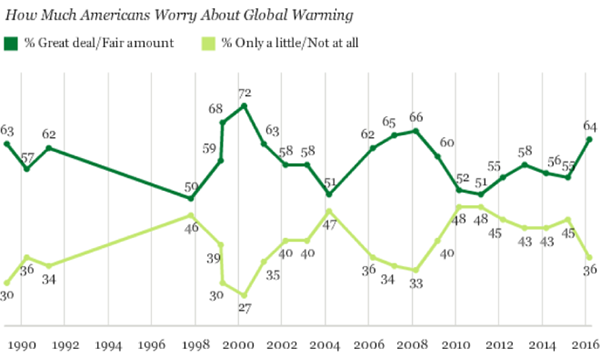
2000 Wave Unsurfed: Just as the 1998–2000 wave of worry about global warming was about to crest, Al Gore elected to campaign on the economy. Any electoral system that forces voters to conflate their politician and policy preferences, which, aside from Uruguay and Switzerland, is pretty much all of them, is perverse and unfit-for-purpose, post Estonia’s emphatic proof of the efficacy of online voting. graph Gallup
Electoral systems that foster trust in citizens to believe their votes matter will be rewarded with higher turnout than those that leave voters frustrated with the unreasonable trade-offs they are forced to make. Currently Labour is receiving a media caning for its less-than-courageous tax policy. For a voter who believes that New Zealand’s foreign aid is cringingly parsimonious, and with neither major party prepared to meaningfully address that, there must be the opportunity to directly nudge policy. Supporting Labour because at least it is not promising tax cuts, doesn’t come close to the fair representation of voters’ policy preferences. It is not difficult to visualise robust, elegant online systems that would allow voters to participate as deeply as they wished. In the 2020 election, many would be happy just to support, or otherwise, Prime Minister Ardern. Many others would be happy just to rank two or more parties. Some, either because they are exercised about many policies and politicians, or because they believe it to be their solemn democratic duty, may be very willing to invest 20 minutes or more expressing more detailed preferences.
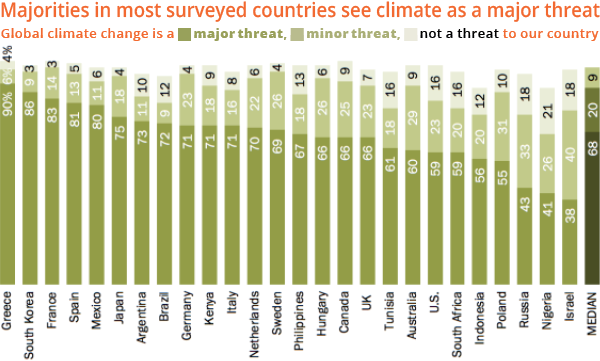
Major Promise: Although the Pew Research Center questions are misleading, to the extent that the global warming already locked in will have a major impact on most countries—a promise, as opposed to a mere threat—support for governments to act is not reflected in the voting patterns, because of the limitations of horse-and-cart-era representative democracies, and the terminal corruption of those, by global business interests. chart Pew Research Center 2018
The one-vote-majority Supreme Court decision ending the 2000 Florida recount was egregious. So too was the electoral college system that converted a more-than-half-million-popular-vote win into a loss. But what was unforgivable was that Al Gore lost for the wrong reason. The then vice president, believing he could not win the 2000 election campaigning on climate, attempted rebirth as a Clintonesque, it’s-the-economy-stupid acolyte. Too few were convinced—Hillary Clinton’s electoral-college loss, at least, was in spite of a 2.9 million popular-vote win. That Gore felt that there was insufficient electoral capital in the three quarters of Americans who, at that time, worried “a great deal” or “a fair amount” about global warming to be elected president speaks to the impossibly conflated choices voters are forced to contend with, and to two-party tribalism.
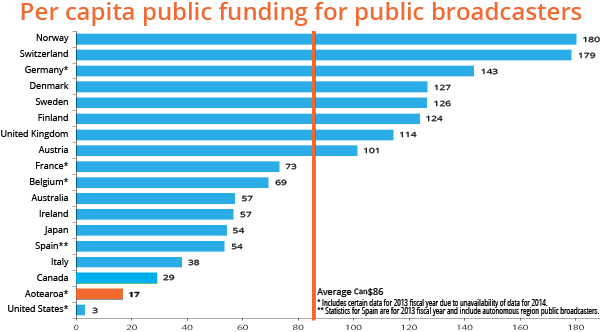
Parsimonious Support for Public Broadcasting: Robust democracy cannot exist without robust public broadcasting, not least of all to provide a modicum of evidence-based ballast against the squalls of talkback-radio toxicity. Currency in Canadian dollars—currently = nz$1.15 chart Nordicity 2014 | labels Mahurangi Magazine
Without building fit-for-purpose electoral systems, the only hope for salvaging a survivable climate is for unusually able and charismatic leaders to succeed in being elected, in sufficient countries. Concern for climate globally is high but is not being reflected by electoral outcomes. This is due to a trifecta of the limitations of horse-and-cart-era representative democracy, the terminal corruption of those by global business interests, and a mainstream media model that, like the political landscape, is owned by the plutocracy. The irony is that, with the internet, never has the fourth estate had such a low-cost means of gathering and disseminating information. But the once proud publish-and-be-damned independence from advertisers has long since been eroded, with publishers having become totally beholden to big business. Government support for public broadcasting in Aotearoa is cravenly neoliberal, at less than 12% of the per capita average of the sort of company New Zealanders typically aspire to keep, of Norway, Switzerland, Germany, Denmark, Sweden, and Finland.
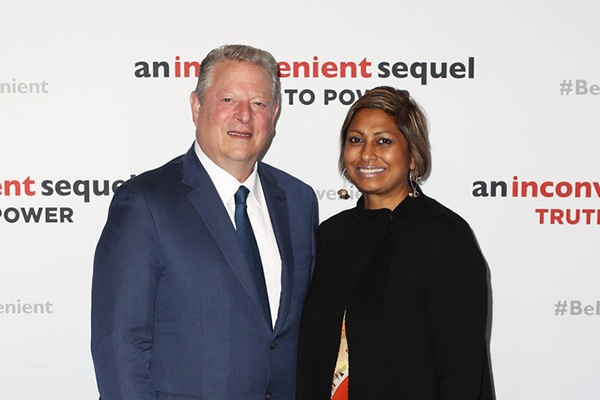
Brilliant Public Broadcaster Back Climate-Knowledgeable: Much-loved broadcaster Indira Naidoo is back with the abc after 23 years, and Al Gore-trained in global warming. Not entirely because Australia spends nearly three times as much per capita on public broadcasting as Aotearoa, anzc spirit should make it natural for Aotearoa and Australia to share such broadcasting talent, and content. image Brendon Thorne | Getty Images | AsiaPac
While capable, climate-knowledgeable leaders could prevail in spite of their inadequate and damaged democratic machinery, to bank on sufficient such leaders assuming power to mobilise meaningful climate action would be reckless in the extreme. Given that climate-action mobilisation will engage humanity for centuries, particularly to adapt to sea-level rise, now is time to build fit-for-purpose democracies, and global democracy. Waiting until climate tipping points are proven to be exceeded to build a better democracy is utterly unconscionable and would be literally catastrophic. But even without the arguably existential imperative for it to be fit-for-purpose:
At least, that is how the International Institute for Democracy and Electoral Assistance puts democracy’s global state, in its 2019 report. Was Aotearoa to exhibit the leadership its historic role as the world’s first full democracy demands, by Democracy Day 2021, on Monday 13 September, most New Zealanders will already have voted. In fact many would have voted more than once, given that Aotearoa would go one better than Estonia in allowing voters to continually revise or enhance their preferences, right up until 6 pm on polling day. In addition to Estonia, Sweden allows “second voting”. While the world will still be in an elevated state of covid-19 disruption, the Mahurangi Magazine would likely be urging readers to consider voting similarly to 2020, had Aotearoa already moved to own Democracy Day:
Prime minister Jacinda Ardern
Party preference 1 Labour Party
Party preference 2 Green Party
Health minister preference 1 Dr Ayesha Verrall
Health minister preference 2 Dr Shane Reti
Energy priority 1 Lake Onslow pumped hydro storage
Energy priority 2 Busway electrification
Housing priority 1 Modular, high-cube-shipping-container-dimensioned, ⪚r3.3-insulation-cored, laminated-wood accommodation, manufactured at scale.
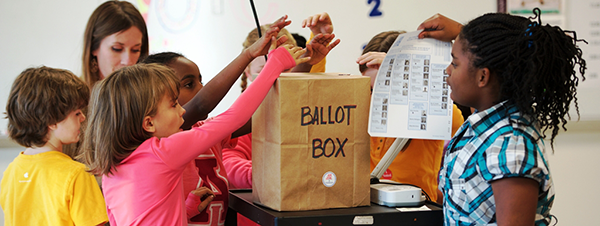
d Day 2021: Call that a democracy; this is a democracy. Or at least it could be. The Kids Voting approach works, whereas regardless of how much money is thrown at adults, they don’t suddenly reform to become lifelong voters—unless the product of coordinated, determined, ongoing evidence-based activism. But even where it was developed, in the United States, it only impacts on about 8.5% of students in any one year. The program is parsimoniously funded in Aotearoa, whereas there is no excuse for is not being part of every school student’s experience. Kids Voting results are the obvious midday d Day curtain-raiser. image Kids Voting Minnesota Network
As regular readers might well imagine, the Mahurangi Magazine’s idealised list of recommendations would be considerably longer, but voters should be facilitated to engage sufficiently to express preferences regarding choices that exercise them. For many, expressing one or two party preferences would suffice. What is outright irresponsible is that the present mmp ballot paper implies that the two-tick, binary, choices on offer are of equal importance. There are only a very few seats like Epsom—where act, which won 0.5% of the party vote, exploited the coattails provision to gain a seat in Parliament—that influence who forms the government. For the vast majority of voters, only their party vote will influence the outcome of the election.
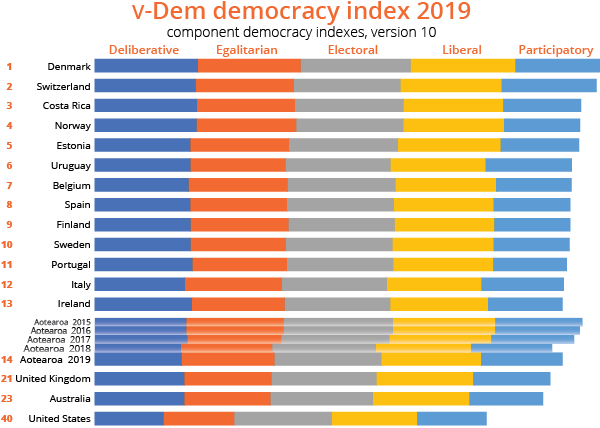
Deliberatively Let Down: Although the Economist Intelligence Unit indexes Aotearoa in fourth place worldwide, its methods are crude compared with those of v-Dem, aka Varieties of Democracy, which places the world’s first full democracy 14th. New Zealand’s weak deliberative-democracy index—albeit nearly 84% of index-winner Denmark—particularly lets “the team of 5 million” down. graph Mahurangi Magazine | data v -Dem 2019, V-Dem v.10
An invariably overlooked deficiency of New Zealand’s implementation of mixed-member proportional, and every other, is its lack of provision for voter-expression of the almost inevitable coalition involved, often only determined after post-election, voter-disrespecting horse trading. Thus, to be democratic, coalition preferences must be enfranchised. The Mahurangi Magazine’s would be:
Coalition exclusion preference 1 New Zealand First
Coalition exclusion preference 2 act New Zealand
(Recent, reactionary, rats-and-mice parties not dignified with a ranking, here.)
The surge in act party popularity is an example of the perils of electoral systems that encourage conflation of policy and party. Routine polling of policy issues such as assisted dying would discourage such aberration.
Hitting the top of the democracy leader board will require action across all aspects of democratic behaviour. Meanwhile, voting in elections providing only marginally more than Hobson’s choices is inexcusably horse-and-cart. Smart, secure online elections would signal to citizens that their votes are what will shape the critical mobilisation to meet the intertwining accommodation, child-poverty, climate, energy, and public health emergencies. That mobilisation must be the economy—an economy beyond consumerism, with the sacred mission of salvaging a survivable climate.
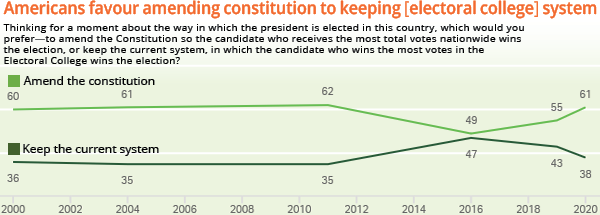
Asking the Right Question: Gallup found that when its abolish-the-electoral-college question was replaced with an amend-the-constitution one, Americans were suddenly in favour of directly electing their president. Even so, in 2016 the margin for reform narrowed to 2 percentage points, thanks to Republican supporters being strongly aware of the undemocratic advantage retaining the perverting electoral college conferred to Trump. chart Gallup | title Mahurangi Magazine
The Mahurangi Magazine’s proposed strategy, in short, is for the world’s first full democracy to rediscover its electoral-system auahatangacreativeness, creativity. Possible alternative here to “mojo”?, and for Aotearoa to demonstrate, every Democracy Day from 2021 onward, that voting for and on mobilisation will indeed reliably mobilise the meaningful climate action the world is desperate for.
Pumped about party preference The Mahurangi Magazine did not expect Prime Minister Jacinda Ardern to boldly nail Lake Onslow colours to Labour’s masthead during the 23 September leaders’ debate. This is the first policy decision, albeit dependent upon the $30 million investigation now being undertaken, taken by Aotearoa, or for that matter, any country, of any material substance in addressing the existential need to slash fossil fuel use. A survivable climate cannot be delivered via the world’s billion cars being powered from battery-stored electricity. Aside from the challenge generating that electricity zero-carbon, the scale of mining, manufacture, and attendant pollution of the battery production would be heinous. Directly grid-powered trolleybuses and trolley-trucks, coupled with the world’s largest, 5-terawatt-hour5 trillion watt-hour, pumped-storage hydroelectricity facility, now that is a “battery”, and that is climate-action mobilisation. This is bigger, in terms of life and health, than the covid-19 pandemic, because it will demonstrate that going hard and going earlyas published: going early and going hard, which is arguably more strategic, but the Ardern phrase has undeniably earned its place in the vernacular, with scientifically sound strategies, is possible. And electable.

Becoming Wise Before the Event: Despite now experiencing 17 pandemics—and 6 of those since 2002—the world was found to be pitifully ill-prepared for when, with predictable unpredictability, this current pandemic manifested. Preparing for the potentially far-deadlier effects of anthropogenic global heating, as well as being an inescapable existential imperative, can, simultaneously, better equip humanity to respond to epidemics, and prevent more becoming pandemics. Here, the initially all-but-imperceptible case-infection rates displayed for India and Indonesia were grave indicators of governments in desperate denial of their countries’ now-destined roles in the raging pandemic—and early exemplar Singapore demonstrates the ruinous consequences of neglecting its most vulnerable workers. Nigeria, however, scams all 207 million of its citizens, by testing fewer than 1% of them, thus hiding the appalling impact of the pandemic there. Australia long-since lost her battle to keep within cooee of covid-19-test-kit-exporter extraordinaire South Korea’s standout response. Aotearoa, meantime, has flat-lined in a good way. All countries’ infection rates are under-reported, some because a few cases, particularly early in the pandemic, are misdiagnosed, but in other countries monstrously, due to dysfunction and/or lack of transparency. The diameter of each line on this graph is proportional to the country’s population. graph Mahurangi Magazine | data Our World in Data 16 November 2020
Join FluTracking now and help prevent future pandemics…
Salutary Lesson in Seasonal Influenza: Physical distancing has also paid dividends in reducing the annual toll extracted by flu that, despite its deadliness, is treated as an inconvenience rather than the killer it is, particularly of the very young, the elderly, and the pregnant—“On average, approximately 400 deaths are attributed to influenza and its complications annually.” covid-19 provided the opportunity to begin collecting flu-symptom data earlier than was done 2018–2019. graph Department of Health Australia | Ministry of Health Aotearoa | labels Mahurangi Magazine
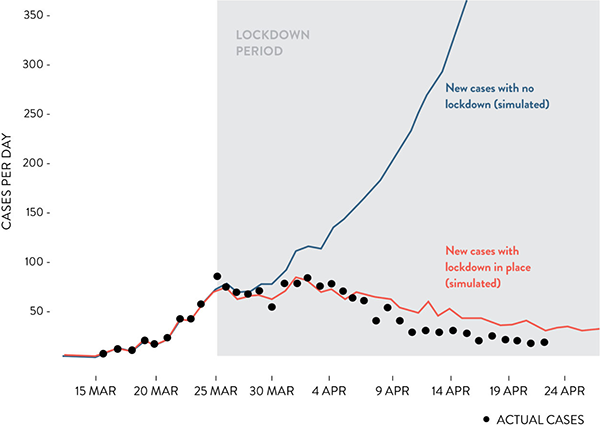
New Zealand’s Altered Future: Moving nine days faster than Ireland, and more emphatically physically distancing, Aotearoa has avoided Ireland’s near vertical trajectory—until the middle of May—of reported covid-19 cases. Ireland’s prime minister then donning his sweats was perhaps great optics, but responding to, for example, fellow general practitioner Dr Marcus de Brun, or to nursing-home representatives more than seven weeks earlier, would have constituted a far more heroic course of action. Aotearoa, for its own survival, now needs to convince the world to alter its determinedly fossil-fuelled future. chart New Zealand Geographic | Te Pūnaha Matatini
Achilles’ Heel of current strategies The following are the two concluding paragraphs of Asymptomatic Transmission, the Achilles’ Heel of Current Strategies to Control Covid-19, published 28 May 2020:
Ultimately, the rapid spread of Covid-19 across the United States and the globe, the clear evidence of SARS-CoV-2 transmission from asymptomatic personsArons MM, Hatfield KM, Reddy SC, et al. Presymptomatic SARS-CoV-2 infections and transmission in a skilled nursing facility. N Engl J Med. DOI: 10.1056/NEJMoa2008457, and the eventual need to relax current social distancing practices argue for broadened SARS-CoV-2 testing to include asymptomatic persons in prioritized settings. These factors also support the case for the general public to use face masks when in crowded outdoor or indoor spaces. This unprecedented pandemic calls for unprecedented measures to achieve its ultimate defeat.
